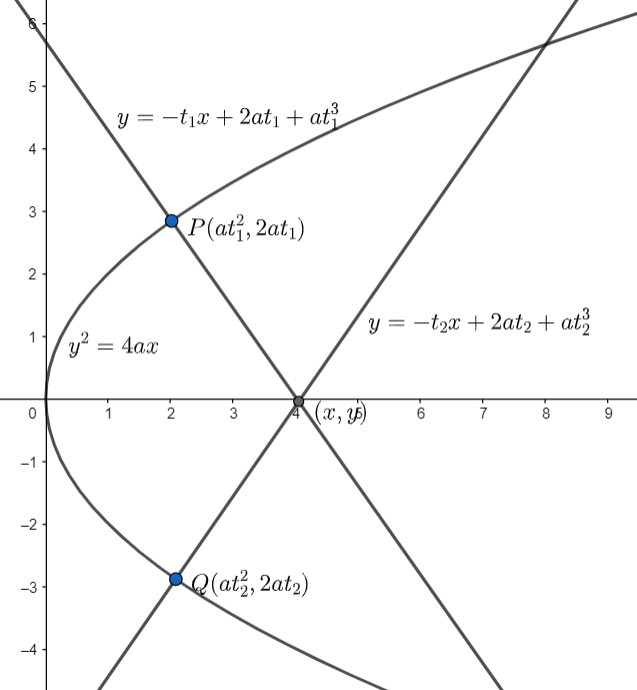Question
Question: Find the point of intersection of normals at \(P\left( {{t}_{1}} \right)\) and \(Q\left( {{t}_{2}} \...
Find the point of intersection of normals at P(t1) and Q(t2) on the parabola y2=4ax .
Solution
Hint: The given problem is related to the equation of normal to parabola in parametric form. The general equation of the normal to the parabola at a point (at2,2at) is given by y=−tx+2at+at3 , where t is a parameter.
Complete step-by-step answer:
We are given the equation of the parabola as y2=4ax .
Now, we will consider two points on the parabola given by P(at12,2at1) and Q(at22,2at2) , where t1 , and t2 are parameters.

Now, we need to find the equation of normal at P and Q .
We know, the general equation of the normal to the parabola at a point (at2,2at) is given by y=−tx+2at+at3 , where t is a parameter.
So, the normal to the parabola at the point P(at12,2at1) will be given is given by substituting t1 in place of t in the general equation of the normal.
On substituting t1 in place of t in the general equation of the normal, we get y=−t1x+2at1+at13....(i) .
And the normal to the parabola at the point Q(at22,2at2) is given as y=−t2x+2at2+at23....(ii) .
Now, to find the point of intersection of (i) and (ii) , we substitute the value of y from equation (i) in equation (ii) .
On substituting the value of y from equation (i) in equation (ii) , we get −t1x+2at1+at13=−t2x+2at2+at23 .
⇒(t2−t1)x=2a(t2−t1)+a(t23−t13)
⇒(t2−t1)x=2a(t2−t1)+a(t2−t1)(t12+t22+t1t2)
⇒x=2a+a(t12+t22+t1t2)
Now, we will substitute x=2a+a(t12+t22+t1t2) in equation (i) .
On substituting x=2a+a(t12+t22+t1t2) in equation (i) , we get y=−t1(2a+a(t12+t22+t1t2))+2at1+at13 .
=−2at1−at13−at22t1−at12t2+2at1+at13
⇒y=−at1t2(t1+t2)
So, the point of intersection of the normal is (2a+a(t12+t22+t1t2),−at1t2(t1+t2)) .
Note: While simplifying the equations, please make sure that sign mistakes do not occur. These mistakes are very common and can confuse while solving. Ultimately the answer becomes wrong. So, sign conventions should be carefully taken.
